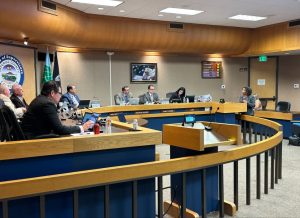The Imperial County Board of Supervisors is considering creating an Infrastructure Financing District in the very near future so it can benefit the region with upcoming projects that will be beneficial for residents at their Oct. 17 meeting.
Through a partnership with the Southern California Association of Governments, Kosmont Companies, a consultant of SCAG, conducted an update of a 2019 Preliminary Feasibility Analysis for the County of Imperial Tax Increment Financing Pilot Project. The updated analysis will incorporate the best practices for district establishment and infrastructure financing and will focus on implementing housing-supportive infrastructure and expanding supply.
Kosmont and SCAG have been working with County staff, since December 2022, to identify the project assessment area and collect vital information needed to conduct the analysis and eventually recommend the best mechanism for a TIF District for the County of Imperial. The analysis is anticipated to be a 12-month process. Kosmont is planning to host two interactive public workshops in the coming months to inform and involve the public in the analysis process.
This study will enable the county to finance infrastructure property from new development and promote housing, economic development, and essential infrastructure. There will be no new taxes on local taxpayers.
EIFDs are funding tools for affordable housing and infrastructure, such as streets, parks, flood control, utilities, and other public improvements. It uses a portion of future local property tax revenues from new development. If implemented, the ability to “value capture” private sector investment and deliver community benefits where needed most.
The objective of this study is to evaluate TIF encompassing various opportunity site areas of the County as a tool for public infrastructure investment. Provide decision-makers with the necessary information for potential District implementation.
It will focus on boundary alternatives, available revenues, potential projects to be funded, public and non-profit/private partners, and district formation.
Sample projects eligible for EIFD funding that has been shared with the County are road and bridge improvements throughout unincorporated towns, utility capacity improvements to catalyze and support new industrial, mining, renewable energy investments, and affordable housing and housing-supportive infrastructure.
Tax increment financing (TIF) works by freezing the property tax revenues that flow from a designated project area to the city, county, and other taxing entities at the “base level” in the current year. Additional tax revenue in future years (the “increment”) is diverted into a separate pool of money, which can be used either to pay for improvements directly or to pay back bonds issued against the anticipated TIF revenue.
In California, TIF has historically been used by redevelopment agencies to raise funding for infrastructure improvements, land assembly, housing, and other projects in redevelopment areas. However, redevelopment agencies in California were required by state law to dissolve as of February 1, 2012. In 2014, with Senate Bill (SB) 628 the State revamped existing Infrastructure Financing Districts into Enhanced Infrastructure Financing Districts (EIFDs). EIFDs are a type of TIF district cities and counties could form to help fund economic development projects. Several legislative measures have passed in the years following that modified SB 628 and EIFD requirements: Assembly Bill 733 (2017) allows for EIFDs to fund climate change adaptation projects, including but not limited to projects that address conditions that impact public health (such as decreased air and water quality, temperatures higher than average, etc.) and extreme weather events (such as sea level rise, heat waves, wildfires, etc.); Senate Bill 1145 (2018) allows EIFDs to also fund infrastructure maintenance costs; Assembly Bill 116 (2019) allows for EIFDs to issue bonds without public vote however does increase public engagement requirements.
With these modifications, EIFDs are currently able to fund infrastructure maintenance and housing development, economic development, transportation infrastructure, sewage treatment, and climate adaptation projects, among other uses. EIFDs do not increase property taxes, as they cannot pull property taxes from school districts. EIFDs are governed by a Public Financing Authority (PFA) made up of 5 members of at least 3 elected officials and 2 local community members who live or work in the district area. The PFA oversees the creation of the District’s Infrastructure Financing Plan (IFP), which outlines the specific projects the district will fund. Additionally, while EIFDs are not required to set aside a specific percentage of affordable housing, all housing that is developed must be affordable.






